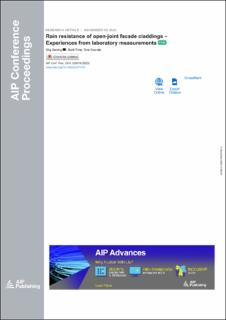| dc.contributor.author | Geving, Stig | |
| dc.contributor.author | Time, Berit | |
| dc.contributor.author | Kvande, Tore | |
| dc.date.accessioned | 2023-11-13T08:02:35Z | |
| dc.date.available | 2023-11-13T08:02:35Z | |
| dc.date.created | 2023-11-11T15:40:00Z | |
| dc.date.issued | 2023 | |
| dc.identifier.issn | 0094-243X | |
| dc.identifier.uri | https://hdl.handle.net/11250/3102043 | |
| dc.description.abstract | Façade claddings with open joints are commonly used in large buildings in Norway. Plane façade panels of fibre cement and high-pressure laminate boards are usually fabricated using joint width of 5 – 10 mm, while solar panel claddings may have joints up to 20 mm. Vertical joints are relatively raintight because the boards are mounted to vertical battens with rubber gaskets placed in between. In contrast, horizontal joints are typically mounted with open joints. The building guidelines recommend that horizontal joints should be protected by small metal profiles to provide rain protection in Norwegian climate. This is unpopular amongst architects as it affects the aesthetics of the horizontal profiles. This study aims to determine the rain resistance of typical open-joint façade claddings, particularly for horizontal joints. The rain testing was performed according to NS-EN 1027:2016 on six different claddings with different horizontal joint openings of 3, 5, and 8 mm. In addition, three horizontal profiles used for protection were tested. Twenty-five different tests were performed. The rain testing demonstrated that the penetration of water through the joint increased with an increase in the joint width. In the case of open horizontal joints, it is impossible to prevent the seepage of water through the joints. The experimental investigation conducted on metal profiles exhibited peculiar results. Two of the three profiles resulted in an increased water seepage behind the panel cladding than that of the open horizontal joints. This was due to the geometric design of the joint profile and the inability to achieve an effective compression between the facade panel and profile. An innovative profile design and supplementary rain testing are required to develop aesthetically acceptable rain tight profiles for open-joint façade claddings. | en_US |
| dc.language.iso | eng | en_US |
| dc.publisher | AIP Publishing | en_US |
| dc.title | Rain resistance of open-joint facade claddings – Experiences from laboratory measurements | en_US |
| dc.title.alternative | Rain resistance of open-joint facade claddings – Experiences from laboratory measurements | en_US |
| dc.type | Peer reviewed | en_US |
| dc.type | Journal article | en_US |
| dc.description.version | publishedVersion | en_US |
| dc.source.volume | 2918 | en_US |
| dc.source.journal | AIP Conference Proceedings | en_US |
| dc.source.issue | 1 | en_US |
| dc.identifier.doi | 10.1063/5.0171107 | |
| dc.identifier.cristin | 2195347 | |
| dc.relation.project | Norges forskningsråd: 237859 | en_US |
| cristin.ispublished | true | |
| cristin.fulltext | original | |
| cristin.qualitycode | 1 | |
